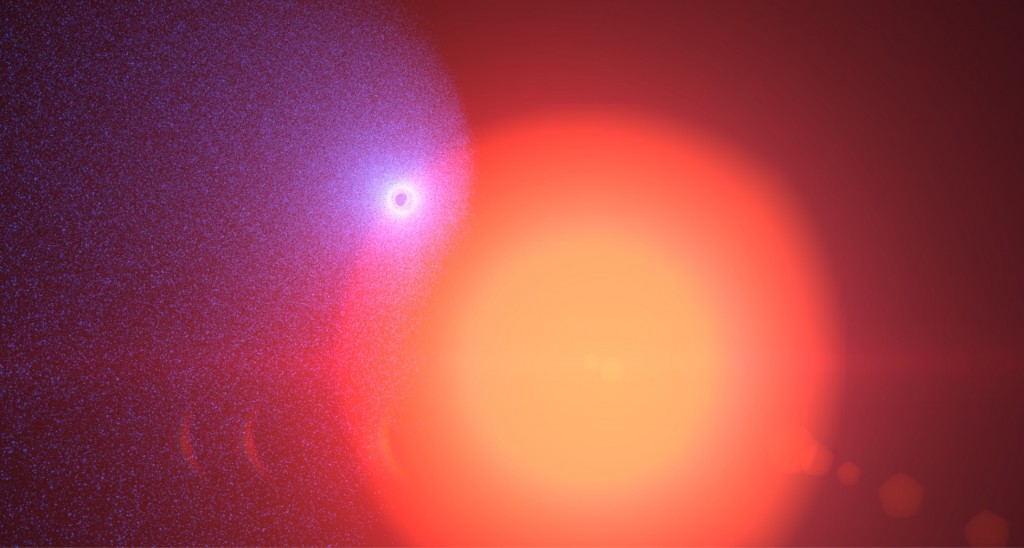
An exoplanet apparently possesses a huge cometlike tail, NASA's New Horizons spacecraft snapped amazing images of Pluto and a solar storm supercharged northern lights displays. Here's a look at Space.com's top stories of the week.
Alien planet masquerades as giant comet
A Neptune-size planet appears to be masquerading as a comet, with a gargantuan stream of gas flowing behind it like a comet's tail. [Full Story: Bizarre Cometlike Alien Planet Is First of Its Kind]
Best-ever photos of Pluto, Charon
NASA's New Horizons spacecraft has spotted a strange dark patch at the pole of Pluto's big moon Charon, further whetting researchers' appetites ahead of the probe's epic flyby of the dwarf planet system next month. [Full Story: Pluto Probe Spies Weird 'Dark Pole' on Big Moon Charon (Photos)]
Auroras blaze up after solar storm
Brilliant streaks of green, purple and pink lit up skies across Canada and many northern U.S. states on Monday night (June 22), in brilliant auroral displays following a massive solar storm. [Full Story: Sun Storm Supercharges Northern Lights, Wowing Skywatchers (Photos)]
Breaking space news, the latest updates on rocket launches, skywatching events and more!
Mission extension for Rosetta comet-studying spacecraft
Europe's Rosetta spacecraft, which is currently orbiting a comet as it hurtles around the sun, has been given nine additional months of operation time and will likely end its life by spiraling down onto the comet's surface, officials said. [Full Story: Rosetta to Spiral onto Comet's Surface After Extended Mission]
SpaceX gears up for another rocket-landing attempt
SpaceX will try once again, on Sunday (June 28), to land the first stage of its Falcon 9 rocket on a boat, and you can watch all the dramatic spaceflight action live. [Full Story: SpaceX to Try Bold Rocket Landing Again Sunday: Watch Live]
Active volcanoes on Venus?
Venus' volcanoes are likely still spewing out lava, a new study suggests.The European Space Agency's Venus Express spacecraft observed temperatures spiking by several hundred degrees Fahrenheit in some spots on the scorching-hot planet's surface. [Full Story: Venus' Volcanoes Are Likely Still Active]
Great new looks at Ceres' strange bright spots
NASA's Dawn spacecraft has beamed home the best-ever photo of the mysterious bright spots that speckle the surface of the dwarf planet Ceres. [Full Story: Ceres' Odd Bright Spots Coming Into Focus (Photos)]
Supermassive black hole as heavy as 140 million suns
A heavyweight black hole in the heart of a distant galaxy has the mass of 140 million suns, according to new measurements. [Full Story: 140 Million Suns! Monster Black Hole Weighs In]
Construction of huge telescope in Hawaii resumes
The group building a huge telescope atop Hawaii's tallest peak plans to restart construction this week, ending a two-month delay caused by protestors opposed to the ambitious project. [Full Story: Construction of Giant Telescope Pushes on Despite Protests]
Robotic submarines could explore Jupiter moon Europa's seas
Researchers are testing out robotic submarines in Antarctica to better understand how to explore the subsurface sea on Jupiter's icy moon Europa. [Full Story: How NASA Could Explore Jupiter Moon Europa's Ocean]
Signs of Mars life could be preserved in 'impact glass'
Newly discovered deposits of glass on Mars resulting from meteorite impacts may be an ideal place to search for signs of Red Planet life, a new study suggests. [Full Story: Martian 'Impact Glass' Could Potentially Preserve Signs of Life]
Follow Mike Wall on Twitter @michaeldwall and Google+. Follow us @Spacedotcom, Facebook or Google+.
Join our Space Forums to keep talking space on the latest missions, night sky and more! And if you have a news tip, correction or comment, let us know at: community@space.com.

Michael Wall is a Senior Space Writer with Space.com and joined the team in 2010. He primarily covers exoplanets, spaceflight and military space, but has been known to dabble in the space art beat. His book about the search for alien life, "Out There," was published on Nov. 13, 2018. Before becoming a science writer, Michael worked as a herpetologist and wildlife biologist. He has a Ph.D. in evolutionary biology from the University of Sydney, Australia, a bachelor's degree from the University of Arizona, and a graduate certificate in science writing from the University of California, Santa Cruz. To find out what his latest project is, you can follow Michael on Twitter.
